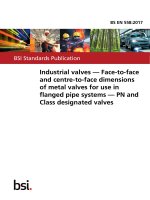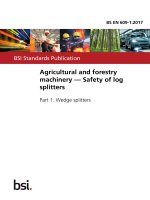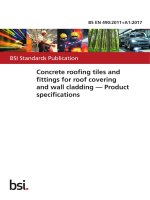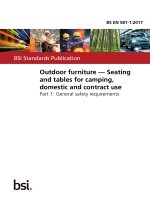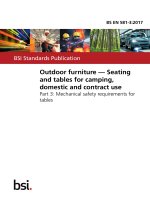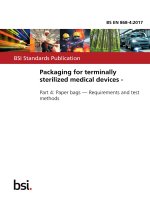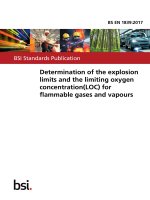Bsi bs en 61605 2017
Bạn đang xem bản rút gọn của tài liệu. Xem và tải ngay bản đầy đủ của tài liệu tại đây (2.08 MB, 18 trang )
BS EN 61605:2017
BSI Standards Publication
Fixed inductors for use in
electronic and telecommunication
equipment — Marking codes
BRITISH STANDARD
BS EN 61605:2017
National foreword
This British Standard is the UK implementation of EN 61605:2017. It is
identical to IEC 61605:2016. It supersedes BS EN 61605:2005 which is
withdrawn.
The UK participation in its preparation was entrusted to Technical
Committee EPL/51, Transformers, inductors, magnetic components and
ferrite materials.
A list of organizations represented on this committee can be obtained on
request to its secretary.
This publication does not purport to include all the necessary provisions of
a contract. Users are responsible for its correct application.
© The British Standards Institution 2017.
Published by BSI Standards Limited 2017
ISBN 978 0 580 92157 5
ICS 29.100.10
Compliance with a British Standard cannot confer immunity from
legal obligations.
This British Standard was published under the authority of the
Standards Policy and Strategy Committee on 28 February 2017.
Amendments/corrigenda issued since publication
Date
Text affected
BS EN 61605:2017
EUROPEAN STANDARD
EN 61605
NORME EUROPÉENNE
EUROPÄISCHE NORM
February 2017
ICS 29.100.10
Supersedes EN 61605:2005
English Version
Fixed inductors for use in electronic and telecommunication
equipment - Marking codes
(IEC 61605:2016)
Inductances fixes utilisées dans les équipements
électroniques et de télécommunications Codes pour le marquage
(IEC 61605:2016)
Festinduktivitäten für elektrische und nachrichtentechnische
Einrichtungen - Kennzeichnungen
(IEC 61605:2016)
This European Standard was approved by CENELEC on 2016-11-30. CENELEC members are bound to comply with the CEN/CENELEC
Internal Regulations which stipulate the conditions for giving this European Standard the status of a national standard without any alteration.
Up-to-date lists and bibliographical references concerning such national standards may be obtained on application to the CEN-CENELEC
Management Centre or to any CENELEC member.
This European Standard exists in three official versions (English, French, German). A version in any other language made by translation
under the responsibility of a CENELEC member into its own language and notified to the CEN-CENELEC Management Centre has the
same status as the official versions.
CENELEC members are the national electrotechnical committees of Austria, Belgium, Bulgaria, Croatia, Cyprus, the Czech Republic,
Denmark, Estonia, Finland, Former Yugoslav Republic of Macedonia, France, Germany, Greece, Hungary, Iceland, Ireland, Italy, Latvia,
Lithuania, Luxembourg, Malta, the Netherlands, Norway, Poland, Portugal, Romania, Serbia, Slovakia, Slovenia, Spain, Sweden,
Switzerland, Turkey and the United Kingdom.
European Committee for Electrotechnical Standardization
Comité Européen de Normalisation Electrotechnique
Europäisches Komitee für Elektrotechnische Normung
CEN-CENELEC Management Centre: Avenue Marnix 17, B-1000 Brussels
© 2017 CENELEC All rights of exploitation in any form and by any means reserved worldwide for CENELEC Members.
Ref. No. EN 61605:2017 E
BS EN 61605:2017
EN 61605:2017
European foreword
The text of document 51/1135/CDV, future edition 3 of IEC 61605, prepared by IEC/TC 51 "Magnetic
components, ferrite and magnetic powder materials" was submitted to the IEC-CENELEC parallel vote
and approved by CENELEC as EN 61605:2017.
The following dates are fixed:
•
latest date by which the document has to be implemented at
national level by publication of an identical national
standard or by endorsement
(dop)
2017-08-30
•
latest date by which the national standards conflicting with
the document have to be withdrawn
(dow)
2019-11-30
This document supersedes EN 61605:2005.
Attention is drawn to the possibility that some of the elements of this document may be the subject of
patent rights. CENELEC [and/or CEN] shall not be held responsible for identifying any or all such
patent rights.
Endorsement notice
The text of the International Standard IEC 61605:2016 was approved by CENELEC as a European
Standard without any modification.
In the official version, for Bibliography, the following note has to be added for the standard indicated :
IEC 60063
2
NOTE
Harmonized as EN 60063.
BS EN 61605:2017
EN 61605:2017
Annex ZA
(normative)
Normative references to international publications
with their corresponding European publications
The following documents, in whole or in part, are normatively referenced in this document and are
indispensable for its application. For dated references, only the edition cited applies. For undated
references, the latest edition of the referenced document (including any amendments) applies.
NOTE 1
When an International Publication has been modified by common modifications, indicated by (mod),
the relevant EN/HD applies.
NOTE 2
Up-to-date information on the latest versions of the European Standards listed in this annex is
available here: www.cenelec.eu.
Publication
Year
Title
EN/HD
Year
ISO 8601
-
Data elements and interchange
formats - Information interchange Representation of dates and times
-
-
3
–2–
BS EN 61605:2017
IEC 61605:2016 © IEC 2016
CONTENTS
FOREWORD ........................................................................................................................... 3
1
Scope .............................................................................................................................. 5
2
Normative references ...................................................................................................... 5
3
Colour code for fixed inductors ........................................................................................ 5
3.1
General rules .......................................................................................................... 5
3.2
Examples of colour code for fixed inductors ............................................................ 6
4
Digit and letter code for inductance values ...................................................................... 7
4.1
General rules .......................................................................................................... 7
4.2
Examples of digit and letter code for inductance values .......................................... 8
5
Letter code for tolerances of inductance values ............................................................... 9
5.1
Symmetrical tolerances ........................................................................................... 9
5.2
Other tolerances ..................................................................................................... 9
6
Date code system for fixed inductors ............................................................................... 9
6.1
Single-character code for year and month ............................................................... 9
6.2
Two-character code for year and month ................................................................ 10
6.3
Four-character code for year and week ................................................................. 11
Bibliography .......................................................................................................................... 12
Figure 1 – Example for 47 μH ± 10 % ...................................................................................... 6
Figure 2 – Example for 4,7 μH ± 2 % ...................................................................................... 7
Figure 3 – Example for 4,7 nH ± 5 %....................................................................................... 7
Table 1 – Values corresponding to colours .............................................................................. 6
Table 2 – Cardinal numbers for the multiplier .......................................................................... 7
Table 3 – Examples of digit and letter code for inductance values ........................................... 8
Table 4 – Letter code for symmetrical tolerance ...................................................................... 9
Table 5 – Single-character code for year and month for a four-year cycle ............................. 10
Table 6 – Code letter for year in a twenty-year cycle ............................................................. 10
Table 7 – Character code letter for month ............................................................................. 11
BS EN 61605:2017
IEC 61605:2016 © IEC 2016
–3–
INTERNATIONAL ELECTROTECHNICAL COMMISSION
____________
FIXED INDUCTORS FOR USE IN ELECTRONIC AND
TELECOMMUNICATION EQUIPMENT – MARKING CODES
FOREWORD
1) The International Electrotechnical Commission (IEC) is a worldwide organization for standardization comprising
all national electrotechnical committees (IEC National Committees). The object of IEC is to promote international
co-operation on all questions concerning standardization in the electrical and electronic fields. To this end and in
addition to other activities, IEC publishes International Standards, Technical Specifications, Technical Reports,
Publicly Available Specifications (PAS) and Guides (hereafter referred to as “IEC Publication(s)”). Their
preparation is entrusted to technical committees; any IEC National Committee interested in the subject dealt with
may participate in this preparatory work. International, governmental and non-governmental organizations liaising
with the IEC also participate in this preparation. IEC collaborates closely with the International Organization for
Standardization (ISO) in accordance with conditions determined by agreement between the two organizations.
2) The formal decisions or agreements of IEC on technical matters express, as nearly as possible, an international
consensus of opinion on the relevant subjects since each technical committee has representation from all
interested IEC National Committees.
3) IEC Publications have the form of recommendations for international use and are accepted by IEC National
Committees in that sense. While all reasonable efforts are made to ensure that the technical content of IEC
Publications is accurate, IEC cannot be held responsible for the way in which they are used or for any
misinterpretation by any end user.
4) In order to promote international uniformity, IEC National Committees undertake to apply IEC Publications
transparently to the maximum extent possible in their national and regional publications. Any divergence between
any IEC Publication and the corresponding national or regional publication shall be clearly indicated in the latter.
5) IEC itself does not provide any attestation of conformity. Independent certification bodies provide conformity
assessment services and, in some areas, access to IEC marks of conformity. IEC is not responsible for any
services carried out by independent certification bodies.
6) All users should ensure that they have the latest edition of this publication.
7) No liability shall attach to IEC or its directors, employees, servants or agents including individual experts and
members of its technical committees and IEC National Committees for any personal injury, property damage or
other damage of any nature whatsoever, whether direct or indirect, or for costs (including legal fees) and expenses
arising out of the publication, use of, or reliance upon, this IEC Publication or any other IEC Publications.
8) Attention is drawn to the Normative references cited in this publication. Use of the referenced publications is
indispensable for the correct application of this publication.
9) Attention is drawn to the possibility that some of the elements of this IEC Publication may be the subject of patent
rights. IEC shall not be held responsible for identifying any or all such patent rights.
International Standard IEC 61605 has been prepared by IEC technical committee 51: Magnetic
components and ferrite materials.
This third edition cancels and replaces the second edition published in 2005. This edition
constitutes a technical revision.
This edition includes the following significant technical changes with respect to the previous
edition:
a) The date code system for fixed inductors has been updated.
The text of this standard is based on the following documents:
CDV
Report on voting
51/1135/CDV
51/1147/RVC
Full information on the voting for the approval of this standard can be found in the report on
voting indicated in the above table.
This publication has been drafted in accordance with the ISO/IEC Directives, Part 2.
–4–
BS EN 61605:2017
IEC 61605:2016 © IEC 2016
The committee has decided that the contents of this publication will remain unchanged until the
stability date indicated on the IEC web site under "" in the data related to
the specific publication. At this date, the publication will be
•
reconfirmed,
•
withdrawn,
•
replaced by a revised edition, or
•
amended.
A bilingual version of this publication may be issued at a later date.
BS EN 61605:2017
IEC 61605:2016 © IEC 2016
–5–
FIXED INDUCTORS FOR USE IN ELECTRONIC AND
TELECOMMUNICATION EQUIPMENT – MARKING CODES
1
Scope
This document specifies marking codes for fixed inductors.
The colour code specified in Clause 3 gives a colour coding for fixed inductors. It is intended for
use with the values of the E3 to E24 series as specified in IEC 60063.
The code specified in Clause 4 gives a system for marking inductance values by means of digits
and letters.
The code specified in Clause 5 gives a system for marking the tolerance on inductance values by
means of letters.
The code specified in Clause 6 gives a system for marking of date codes on fixed inductors by
means of letters and digits.
2
Normative references
The following documents are referred to in the text in such a way that some or all of their content
constitutes requirements of this document. For dated references, only the edition cited applies.
For undated references, the latest edition of the referenced document (including any
amendments) applies.
ISO 8601, Data elements and interchange formats – Information interchange – Representation
of dates and times
3
3.1
Colour code for fixed inductors
General rules
Colour codes for fixed inductors should be expressed in “bands”. If other shapes than bands are
applied, the relevant specification shall prescribe their configuration, placement and
identification.
Colour codes for fixed inductors shall consist of four bands. The first three bands shall indicate
inductance values and the last band shall indicate tolerances.
Inductance values shall be expressed by two significant figures and another figure expressing
multipliers.
Colour corresponding to significant figures, multipliers and tolerances shall be as given in Table 1.
The first two bands represent significant figures and the third band specifies the multiplier. The
basic unit for the inductance value shall be expressed in µH. The first band shall be the one
nearest to the end of the inductor and the bands shall be so placed and spaced that there can be
no confusion in reading the coding.
Any additional coding on fixed inductors shall be applied in such a way as not to confuse the
coding for value and tolerance.
BS EN 61605:2017
IEC 61605:2016 © IEC 2016
–6–
Table 1 – Values corresponding to colours
Colour
Significant figure
Multiplier
Tolerance
Silver
–
10 –2
± 10
Gold
–
10 –1
±5
Black
0
10 0
–
Brown
1
10 1
±1
Red
2
10 2
±2
3
10 3
–
4
10 4
–
5
10 5
–
6
10 6
–
7
10 –3
–
Grey
8
10 –4
–
White
9
–
–
None
–
–
± 20
%
Orange
Yellow
Green
Blue
Violet
3.2
Examples of colour code for fixed inductors
The examples of colour code for fixed inductors are shown in Figure 1, Figure 2 and Figure 3.
1
2
3
4
IEC
Key:
1: 1 st band
Yellow
=4
Violet
=7
nd
band
2 nd
3 rd
band
Multiplier
Black
= × 10 0
Tolerance
Silver
= ± 10 %
2: 2
3:
1 st numeral
4: 4 th band
numeral
Figure 1 – Example for 47 μH ± 10 %
BS EN 61605:2017
IEC 61605:2016 © IEC 2016
–7–
1
2
3
4
IEC
Key:
1: 1 st band
nd
3 rd
2: 2
3:
1 st numeral
Yellow
=4
band
2 nd
Violet
=7
band
Multiplier
Gold
= × 10 -1
Tolerance
Red
=±2%
4: 4 th band
numeral
Figure 2 – Example for 4,7 μH ± 2 %
1
2
3
4
IEC
Key:
1: 1 st band
Yellow
=4
Violet
=7
nd
band
2 nd
3 rd
band
Multiplier
Grey
= × 10 -4
Tolerance
Gold
=±5%
2: 2
3:
1 st numeral
4: 4 th band
numeral
Figure 3 – Example for 4,7 nH ± 5 %
4
4.1
Digit and letter code for inductance values
General rules
Nominal inductance values shall be expressed in three characters of letters and digits.
Where inductance values are equal to, or greater than, 10 µH, the first two characters indicate
significant figures and the last one indicates multipliers. In this case, cardinal numbers for the
multiplier shall be as given in Table 2.
Table 2 – Cardinal numbers for the multiplier
Cardinal number
Multiplier
0
1
2
3
4
5
6
7
8
9
–
10 0
10 1
10 2
10 3
10 4
10 5
10 6
–
–
–
–
BS EN 61605:2017
IEC 61605:2016 © IEC 2016
–8–
Inductance values less than 10 µH and equal to, or greater than, 100 nH shall be identified with
two numbers representing the significant figures and the letter (R) designating decimal point
location µH, and the letter (N) designating decimal point location of nH for the inductance value
of less than 100 nH.
4.2
Examples of digit and letter code for inductance values
Examples of digit and letter code for inductance values are shown in Table 3.
Table 3 – Examples of digit and letter code for inductance values
Inductance values
Digit and letter code
0,1 nH
N10
0,47 nH
N47
1 nH
1N0
4,7 nH
4N7
10 nH
10N
47 nH
47N
0,1 µH
R10
0,47 µH
R47
1 µH
1R0
4,7 µH
4R7
10 µH
100
47 µH
470
100 µH
101
470 µH
471
1 mH
102
4,7 mH
472
10 mH
103
47 mH
473
100 mH
104
470 mH
474
1H
105
4,7 H
475
10 H
106
47 H
476
BS EN 61605:2017
IEC 61605:2016 © IEC 2016
5
5.1
–9–
Letter code for tolerances of inductance values
Symmetrical tolerances
The letter codes shown in Table 4 shall be used to indicate the symmetrical tolerance on
inductance values.
Table 4 – Letter code for symmetrical tolerance
Tolerance
Letter code
± 0,05 nH
W
± 0,1 nH
B
± 0,2 nH
C
± 0,3 nH
S
± 0,5 nH
D
±1%
F
±2%
G
±3%
H
±5%
J
± 10 %
K
± 15 %
L
± 20 %
M
± 30 %
N
These letter codes shall be placed after the inductance values.
5.2
Other tolerances
For tolerances for which a code letter has not been laid down, the letter A may be used. The
letter A indicates that the tolerance is to be identified in other documents.
6
6.1
Date code system for fixed inductors
Single-character code for year and month
Date codes of year and month in single-character shall be expressed in the code system shown
in Table 5 and should be repeated every four years.
BS EN 61605:2017
IEC 61605:2016 © IEC 2016
– 10 –
Table 5 – Single-character code for year and month for a four-year cycle
Year
Month
Letter
Year
Month
Letter
Year
Month
Letter
Year
Month
Letter
2001
Jan.
A
2002
Jan.
N
2003
Jan.
a
2004
Jan.
n
2005
Feb.
B
2006
Feb.
P
2007
Feb.
b
2008
Feb.
p
2009
Mar.
C
2010
Mar.
Q
2011
Mar.
c
2012
Mar.
q
2013
Apr.
D
2014
Apr.
R
2015
Apr.
d
2016
Apr.
r
2017
May
E
2018
May
S
2019
May
e
2020
May
s
2021
Jun.
F
2022
Jun.
T
2023
Jun.
f
2024
Jun.
t
2025
Jul.
G
2026
Jul.
U
2027
Jul.
g
2028
Jul.
u
2029
Aug.
H
2030
Aug.
V
2031
Aug.
h
2032
Aug.
v
2033
Sep.
J
2034
Sep.
W
2035
Sep.
j
2036
Sep.
w
2037
Oct.
K
2038
Oct.
X
2039
Oct.
k
2040
Oct.
x
・
Nov.
L
・
Nov.
Y
・
Nov.
l
・
Nov.
y
・
Dec.
M
・
Dec.
Z
・
Dec.
m
・
Dec.
z
NOTE 1 Those codes which indicate the year and month with one capital letter and small letter, except “I” and “O”,
repeat after each cycle of four years.
NOTE 2 If there is a possibility that a single lower-case letter could be read as an upper-case letter, for example,
v for V, the lower-case letter could be marked with a cross bar above it.
The examples for Table 5 are shown as follows:
June 2016
=t
November 2017
=L
6.2
Two-character code for year and month
Where the date codes of the year and month of the manufacture are required as two-character
codes, the code system shown in Table 6 and Table 7 shall be used.
Table 6 – Code letter for year in a twenty-year cycle
Year
Letter
Year
Letter
Year
Letter
Year
Letter
Year
Letter
|
|
2017
J
2026
U
2035
F
2044
S
↓
↓
2018
K
2027
V
2036
H
2045
T
2010
A
2019
L
2028
W
2037
J
2046
U
2011
B
2020
M
2029
X
2038
K
2047
V
2012
C
2021
N
2030
A
2039
L
2048
W
2013
D
2022
P
2031
B
2040
M
2049
X
2014
E
2023
R
2032
C
2041
N
2050
A
2015
F
2024
S
2033
D
2042
P
|
|
2016
H
2025
T
2034
E
2043
R
↓
↓
NOTE
These codes, which indicate the year, repeat after each cycle of 20 years.
BS EN 61605:2017
IEC 61605:2016 © IEC 2016
– 11 –
Table 7 – Character code letter for month
Month
Character
Month
Character
January
1
July
7
February
2
August
8
March
3
September
9
April
4
October
O
May
5
November
N
June
6
December
D
The examples for Table 6 and Table 7 are shown as follows:
6.3
March 2023
= R3
November 2025
= TN
Four-character code for year and week
Where the date codes of the year and week of manufacture are required, the code system shall
use four figures. The first two figures shall be the last two figures of the year and the last two
figures shall be the numbering of the week. The numbering of the week shall be in accordance
with ISO 8601, as follows:
Tenth week of 2019
= 1910
Forty-second week of 2024
= 2442
– 12 –
Bibliography
IEC 60063, Preferred number series for resistors and capacitors
___________
BS EN 61605:2017
IEC 61605:2016 © IEC 2016
This page deliberately left blank
NO COPYING WITHOUT BSI PERMISSION EXCEPT AS PERMITTED BY COPYRIGHT LAW
British Standards Institution (BSI)
BSI is the national body responsible for preparing British Standards and other
standards-related publications, information and services.
BSI is incorporated by Royal Charter. British Standards and other standardization
products are published by BSI Standards Limited.
About us
Reproducing extracts
We bring together business, industry, government, consumers, innovators
and others to shape their combined experience and expertise into standards
-based solutions.
For permission to reproduce content from BSI publications contact the BSI
Copyright & Licensing team.
The knowledge embodied in our standards has been carefully assembled in
a dependable format and refined through our open consultation process.
Organizations of all sizes and across all sectors choose standards to help
them achieve their goals.
Information on standards
We can provide you with the knowledge that your organization needs
to succeed. Find out more about British Standards by visiting our website at
bsigroup.com/standards or contacting our Customer Services team or
Knowledge Centre.
Buying standards
You can buy and download PDF versions of BSI publications, including British
and adopted European and international standards, through our website at
bsigroup.com/shop, where hard copies can also be purchased.
If you need international and foreign standards from other Standards Development
Organizations, hard copies can be ordered from our Customer Services team.
Copyright in BSI publications
All the content in BSI publications, including British Standards, is the property
of and copyrighted by BSI or some person or entity that owns copyright in the
information used (such as the international standardization bodies) and has
formally licensed such information to BSI for commercial publication and use.
Save for the provisions below, you may not transfer, share or disseminate any
portion of the standard to any other person. You may not adapt, distribute,
commercially exploit, or publicly display the standard or any portion thereof in any
manner whatsoever without BSI’s prior written consent.
Storing and using standards
Standards purchased in soft copy format:
• A British Standard purchased in soft copy format is licensed to a sole named
user for personal or internal company use only.
• The standard may be stored on more than 1 device provided that it is accessible
by the sole named user only and that only 1 copy is accessed at any one time.
• A single paper copy may be printed for personal or internal company use only.
Standards purchased in hard copy format:
• A British Standard purchased in hard copy format is for personal or internal
company use only.
• It may not be further reproduced – in any format – to create an additional copy.
This includes scanning of the document.
If you need more than 1 copy of the document, or if you wish to share the
document on an internal network, you can save money by choosing a subscription
product (see ‘Subscriptions’).
Subscriptions
Our range of subscription services are designed to make using standards
easier for you. For further information on our subscription products go to
bsigroup.com/subscriptions.
With British Standards Online (BSOL) you’ll have instant access to over 55,000
British and adopted European and international standards from your desktop.
It’s available 24/7 and is refreshed daily so you’ll always be up to date.
You can keep in touch with standards developments and receive substantial
discounts on the purchase price of standards, both in single copy and subscription
format, by becoming a BSI Subscribing Member.
PLUS is an updating service exclusive to BSI Subscribing Members. You will
automatically receive the latest hard copy of your standards when they’re
revised or replaced.
To find out more about becoming a BSI Subscribing Member and the benefits
of membership, please visit bsigroup.com/shop.
With a Multi-User Network Licence (MUNL) you are able to host standards
publications on your intranet. Licences can cover as few or as many users as you
wish. With updates supplied as soon as they’re available, you can be sure your
documentation is current. For further information, email
Revisions
Our British Standards and other publications are updated by amendment or revision.
We continually improve the quality of our products and services to benefit your
business. If you find an inaccuracy or ambiguity within a British Standard or other
BSI publication please inform the Knowledge Centre.
Useful Contacts
Customer Services
Tel: +44 345 086 9001
Email (orders):
Email (enquiries):
Subscriptions
Tel: +44 345 086 9001
Email:
Knowledge Centre
Tel: +44 20 8996 7004
Email:
Copyright & Licensing
Tel: +44 20 8996 7070
Email:
BSI Group Headquarters
389 Chiswick High Road London W4 4AL UK
